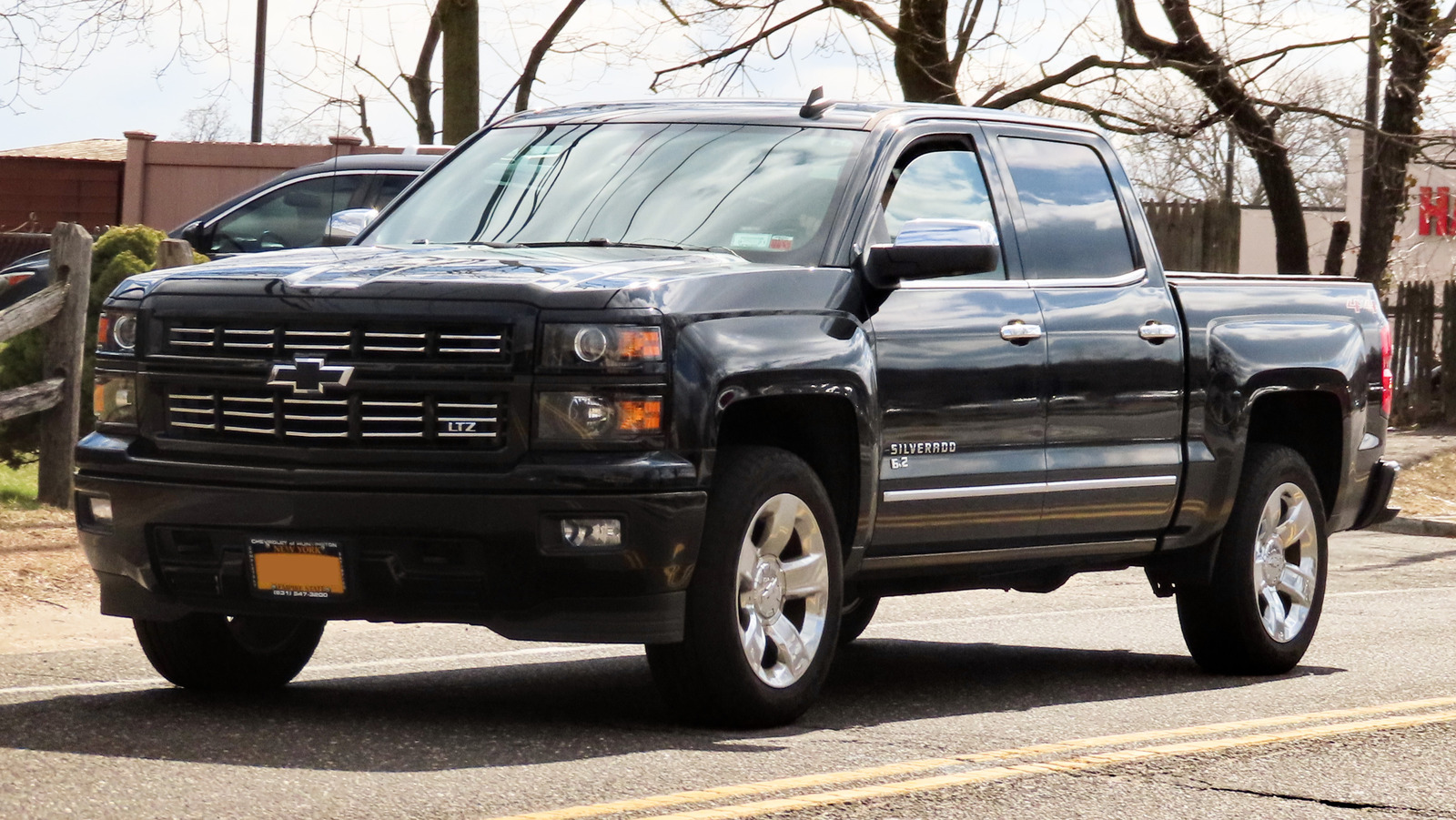
The Chevy Silverado has been one of America’s best-selling half-ton pickups for decades, but not every model year has earned that reputation through reliability. Every truck has its bad years, but the third-generation (K2) Silverado — built from 2014 to 2018 — has become known for all the wrong reasons. And within that run, the 2015 model year stands out. It has been the subject of 23 separate NHTSA recalls, covering everything from brakes and steering to seat belts and software glitches.
Common trouble spots include brake assist loss from a failing vacuum pump, collapsed AFM lifters on V8s, steering assist that drops out unexpectedly, A/C condensers that leak and quit cooling, and rear defrosters capable of overheating and shattering glass. Each has either a recall, special coverage, or a run of technical bulletins, plus years of corroborating forum threads. But the tricky part about recalls is that not every affected truck gets repaired, leaving many problems to resurface years later.
That’s why the 2015 Silverado still draws warnings across forums like Reddit and GM-Trucks.com, where later buyers recount picking up one used between 2021 and 2025 only to face those same expensive, safety-critical defects within months. With over 600,000 units sold in 2015 alone, the pool of affected Silverados is enormous, and the odds of inheriting a truck with those headaches are high enough that many buyers now flag this specific model year as one to avoid.
Brakes are the one system you can’t afford to lose confidence in, and for a work truck like the Silverado, that confidence is non-negotiable. Yet dozens of 2015 owners have reported the brake pedal suddenly going rock-hard, requiring excessive force, and leaving the truck taking much longer to stop. The issue shows up most often at low speeds in stop-and-go traffic or parking lots, where drivers least expect the pedal to feel unassisted.
The problem triggered a federal investigation (PE18-012), and GM responded with both a recall (19V645) and a Special Coverage bulletin (N182202780). The culprit is the engine-driven vacuum pump, that wears down with age and eventually fails to supply enough boost to the brake system. The fix included a calibration update and an extended warranty covering 10 years or 150,000 miles — but only for vehicles already showing symptoms.
Despite these measures, many owners discovered the issue only after buying used 2015 Chevy Silverados later — well outside the coverage window. Forums are filled with 2015 Silverado complaints from used-truck buyers discovering the issue just months after purchase. Others report paying out-of-pocket for replacement pumps after narrowly missing coverage. And since the failure is usage-based and often develops slowly, it can go unnoticed until assist is practically gone. For buyers of a 2015 Silverado, the risk of inheriting a truck with this unresolved brake issue is high and a good reason to walk away.
The 5.3-liter (L83) and 6.2-liter (L86) V8s offered in the 2015 Chevy Silverado came with GM’s AFM system, a cylinder-deactivation feature designed to squeeze out better fuel economy. On paper, it’s clever technology. In practice, it has proven to be one of the generation’s biggest mechanical headaches. The AFM lifters themselves are prone to collapsing or sticking, which throws the engine into chaos. Symptoms cluster around a loud tick, random misfires (often setting a P0300 code), rough idle, limp-home mode, and noticeable loss of power.
GM acknowledged the issue in TSBs 15-06-01-002A and more, covering the K2 trucks and even the same-era Corvette. But those bulletins stop short of offering warranty coverage for most 2015 trucks. And unlike minor sensor swaps, lifter failure almost always means a major teardown. The typical repair involves replacing all lifter assemblies, and in many cases, the camshaft and gaskets as well. At dealership rates, that adds up quickly to a $3,000-$5,000 bill.
The risk doesn’t stop once the work is done. Owners report repeat failures when replacement lifters are poorly installed or when fresh parts give out prematurely. That means a used 2015 Chevy Silverado can be a financial trap; you either inherit a truck already headed for this repair, or pay extra for one that’s been “fixed” but may fail again. Since these trucks are now well outside their factory powertrain warranty, buyers are on the hook. In some states, repeated lifter failures could qualify under lemon-law protections, but again, that’s a complicated uphill battle for most buyers.
The 2015 Chevrolet Silverado’s electric power steering (EPS) system has a well-documented flaw that can catch drivers off guard. Owners describe the wheel suddenly going heavy in parking lots or tight turns, usually right after startup, before the assist kicks back in like nothing happened. If you’re trying to maneuver a 5,000-pound truck in a tight space, it can feel like the wheel is fighting you.
It wasn’t just a handful of trucks, either. The NHTSA logged over a hundred steering-related complaints for the 2015 model, some of them describing the same sequence: the steering wheel locks up, the StabiliTrak warning light flashes on, and in some cases the truck loses power or stalls entirely during a turn. The workaround most drivers discovered was to stop, turn the ignition off, and restart — hardly a confidence-inspiring fix on a busy intersection.
GM formally addressed the problem in Recall 18V586, which affected more than a million vehicles across its truck and SUV lineup. The cause was traced to voltage dips that triggered the EPS module to shut down. The official fix was a software update, but owners still report steering assist failures — sometimes even after resets or on trucks excluded from the recall despite identical symptoms. Taken together with the vacuum pump failure that affected braking, it paints a picture of a model year plagued by two critical system defects — the kind of paperwork no truck owner wants to inherit, especially years later when recalls may already be ignored or closed.
On 2015 Chevy Silverados, the power-sliding rear window was an optional unit (available on Double Cab and Crew Cab) that integrated an electric defroster grid into the glass. Not every truck came with the option, but those that did inherit one of the model year’s stranger — and more alarming — flaws. Trucks equipped with the option have a history of overheating electrical contacts built into the glass. In a best-case scenario, it stops working. In worst cases, owners across GM forums and complaint databases describe hearing a pop or hiss, followed by smoke, melted trim, or the entire pane of glass shattering.
GM issued a customer-satisfaction campaign (N192265660) to replace faulty sliding rear glass assemblies and repair the wiring harness, but the issue didn’t fully disappear. Transport Canada later escalated it to a full recall in 2024, noting that some prior repairs weren’t effective. In the U.S., N192265660 was targeted primarily at cold-weather states and was time-limited — “in effect until February 28, 2022” — so later buyers may still encounter used trucks that were never repaired. And this isn’t a cheap repair. If your truck is out of coverage, replacing the sliding glass can cost up to $1,730. And because the sliding window was a popular option on higher trims, this issue disproportionately affects buyers looking for a better-equipped 2015 Chevrolet Silverado on the used market.
Unlike the rear-defroster issue, air-conditioning failure on the 2015 Silverado is both widespread and specific in its cause. Owners describe recharging the refrigerant, enjoying cold air for a week or two, and then watching the vents blow hot again. The root cause is usually the A/C condenser, which has a seam that’s prone to cracking and leaking refrigerant. Once that happens, the system can’t hold a charge.
GM acknowledged the problem across its K2 platform by issuing Special Coverage 17336 for other K2 SUVs like the Tahoe and Suburban, where the same condenser design was used — not for the 2015 Silverado 1500 — so many pickup owners report paying out of pocket for condenser replacements once the basic warranty ends. CarComplaint database shows dozens of “A/C blowing hot air” cases tied to condensers on the 2015 Silverado, with a typical repair bill around $1,100; forum posts capture recent (2020–2025) used-truck buyers discovering leaks shortly after purchase. While a failed condenser won’t strand the truck, it’s a chronic quality-of-life issue, especially on worksites where the A/C is expected to pull its weight. In hotter states, it can be miserable enough to make an otherwise solid used truck feel like the wrong choice.



